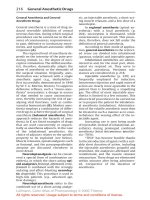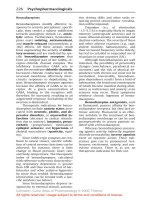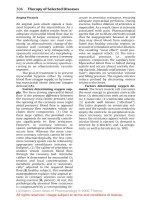Color Atlas of Pharmacology (Part 19): Local Anesthetics
Bạn đang xem bản rút gọn của tài liệu. Xem và tải ngay bản đầy đủ của tài liệu tại đây (409.96 KB, 12 trang )
Local Anesthetics
Local anesthetics reversibly inhibit im-
pulse generation and propagation in
nerves. In sensory nerves, such an effect
is desired when painful procedures
must be performed, e.g., surgical or den-
tal operations.
Mechanism of action. Nerve im-
pulse conduction occurs in the form of
an action potential, a sudden reversal in
resting transmembrane potential last-
ing less than 1 ms. The change in poten-
tial is triggered by an appropriate stim-
ulus and involves a rapid influx of Na
+
into the interior of the nerve axon (A).
This inward flow proceeds through a
channel, a membrane pore protein, that,
upon being opened (activated), permits
rapid movement of Na
+
down a chemi-
cal gradient ([Na
+
]
ext
~ 150 mM, [Na
+
]
int
~ 7 mM). Local anesthetics are capable
of inhibiting this rapid inward flux of
Na
+
; initiation and propagation of exci-
tation are therefore blocked (A).
Most local anesthetics exist in part
in the cationic amphiphilic form (cf. p.
208). This physicochemical property fa-
vors incorporation into membrane
interphases, boundary regions between
polar and apolar domains. These are
found in phospholipid membranes and
also in ion-channel proteins. Some evi-
dence suggests that Na
+
-channel block-
ade results from binding of local anes-
thetics to the channel protein. It appears
certain that the site of action is reached
from the cytosol, implying that the drug
must first penetrate the cell membrane
(p. 206).
Local anesthetic activity is also
shown by uncharged substances, sug-
gesting a binding site in apolar regions
of the channel protein or the surround-
ing lipid membrane.
Mechanism-specific adverse ef-
fects. Since local anesthetics block Na
+
influx not only in sensory nerves but al-
so in other excitable tissues, they are
applied locally and measures are taken
(p. 206) to impede their distribution
into the body. Too rapid entry into the
circulation would lead to unwanted
systemic reactions such as:
¼
blockade of inhibitory CNS neurons,
manifested by restlessness and sei-
zures (countermeasure: injection of a
benzodiazepine, p. 226); general par-
alysis with respiratory arrest after
higher concentrations.
¼
blockade of cardiac impulse conduc-
tion, as evidenced by impaired AV
conduction or cardiac arrest (coun-
termeasure: injection of epineph-
rine). Depression of excitatory pro-
cesses in the heart, while undesired
during local anesthesia, can be put to
therapeutic use in cardiac arrhythmi-
as (p. 134).
Forms of local anesthesia. Local
anesthetics are applied via different
routes, including infiltration of the tis-
sue (infiltration anesthesia) or injec-
tion next to the nerve branch carrying
fibers from the region to be anesthe-
tized (conduction anesthesia of the
nerve, spinal anesthesia of segmental
dorsal roots), or by application to the
surface of the skin or mucosa (surface
anesthesia). In each case, the local an-
esthetic drug is required to diffuse to
the nerves concerned from a depot
placed in the tissue or on the skin.
High sensitivity of sensory nerves,
low sensitivity of motor nerves. Im-
pulse conduction in sensory nerves is
inhibited at a concentration lower than
that needed for motor fibers. This differ-
ence may be due to the higher impulse
frequency and longer action potential
duration in nociceptive, as opposed to
motor, fibers.
Alternatively, it may be related to
the thickness of sensory and motor
nerves, as well as to the distance
between nodes of Ranvier. In saltatory
impulse conduction, only the nodal
membrane is depolarized. Because de-
polarization can still occur after block-
ade of three or four nodal rings, the area
exposed to a drug concentration suffi-
cient to cause blockade must be larger
for motor fibers (p. 205B).
This relationship explains why sen-
sory stimuli that are conducted via
204 Local Anesthetics
Lüllmann, Color Atlas of Pharmacology © 2000 Thieme
All rights reserved. Usage subject to terms and conditions of license.
Local Anesthetics 205
+
A. Effects of local anesthetics
B. Inhibition of impulse conduction in different types of nerve fibers
Local anesthetic
Na
+
-entry
Propagated
impulse
Peripheral nerve
Conduction
block
Local
application
CNS
Restlessness,
convulsions,
respiratory
paralysis
Heart
Impulse
conduction
cardiac arrest
Na
+
Activated
Na
+
-channel
Na
+
Blocked
Na
+
-channel
apolar
polar Cationic
amphiphilic
local
anesthetic
Local anesthetic
A! motor 0.8 – 1.4 mm
0.3 – 0.7 mm
A" sensory
C sensory and
postganglionic
Na
+
Blocked
Na
+
-channel
Uncharged
local
anesthetic
Lüllmann, Color Atlas of Pharmacology © 2000 Thieme
All rights reserved. Usage subject to terms and conditions of license.
myelinated A"-fibers are affected later
and to a lesser degree than are stimuli
conducted via unmyelinated C-fibers.
Since autonomic postganglionic fibers
lack a myelin sheath, they are particu-
larly susceptible to blockade by local
anesthetics. As a result, vasodilation en-
sues in the anesthetized region, because
sympathetically driven vasomotor tone
decreases. This local vasodilation is un-
desirable (see below).
Diffusion and Effect
During diffusion from the injection site
(i.e., the interstitial space of connective
tissue) to the axon of a sensory nerve,
the local anesthetic must traverse the
perineurium. The multilayered peri-
neurium is formed by connective tissue
cells linked by zonulae occludentes
(p. 22) and therefore constitutes a
closed lipophilic barrier.
Local anesthetics in clinical use are
usually tertiary amines; at the pH of
interstitial fluid, these exist partly as the
neutral lipophilic base (symbolized by
particles marked with two red dots) and
partly as the protonated form, i.e., am-
phiphilic cation (symbolized by parti-
cles marked with one blue and one red
dot). The uncharged form can penetrate
the perineurium and enters the endo-
neural space, where a fraction of the
drug molecules regains a positive
charge in keeping with the local pH. The
same process is repeated when the drug
penetrates the axonal membrane (axo-
lemma) into the axoplasm, from which
it exerts its action on the sodium chan-
nel, and again when it diffuses out of the
endoneural space through the unfenes-
trated endothelium of capillaries into
the blood.
The concentration of local anes-
thetic at the site of action is, therefore,
determined by the speed of penetration
into the endoneurium and the speed of
diffusion into the capillary blood. In or-
der to ensure a sufficiently fast build-up
of drug concentration at the site of ac-
tion, there must be a correspondingly
large concentration gradient between
drug depot in the connective tissue and
the endoneural space. Injection of solu-
tions of low concentration will fail to
produce an effect; however, too high
concentrations must also be avoided be-
cause of the danger of intoxication re-
sulting from too rapid systemic absorp-
tion into the blood.
To ensure a reasonably long-lasting
local effect with minimal systemic ac-
tion, a vasoconstrictor (epinephrine,
less frequently norepinephrine (p. 84)
or a vasopressin derivative; p. 164) is of-
ten co-administered in an attempt to
confine the drug to its site of action. As
blood flow is diminished, diffusion from
the endoneural space into the capillary
blood decreases because the critical
concentration gradient between endo-
neural space and blood quickly becomes
small when inflow of drug-free blood is
reduced. Addition of a vasoconstrictor,
moreover, helps to create a relative
ischemia in the surgical field. Potential
disadvantages of catecholamine-type
vasoconstrictors include reactive hy-
peremia following washout of the con-
strictor agent (p. 90) and cardiostimula-
tion when epinephrine enters the sys-
temic circulation. In lieu of epinephrine,
the vasopressin analogue felypressin
(p. 164, 165) can be used as an adjunc-
tive vasoconstrictor (less pronounced
reactive hyperemia, no arrhythmogenic
action, but danger of coronary constric-
tion). Vasoconstrictors must not be ap-
plied in local anesthesia involving the
appendages (e.g., fingers, toes).
206 Local Anesthetics
Lüllmann, Color Atlas of Pharmacology © 2000 Thieme
All rights reserved. Usage subject to terms and conditions of license.
Local Anesthetics 207
A. Disposition of local anesthetics in peripheral nerve tissue
Vasoconstriction
e.g., with epinephrine
lipophilic
amphiphilic
Axolemma
Axoplasm
Axolemma
Axoplasm
Inter-
stitium
Cross section through peripheral
nerve (light microscope)
Peri-
neurium
Endoneural
space
Capillary
wall
Axon
0.1 mm
Interstitium
Lüllmann, Color Atlas of Pharmacology © 2000 Thieme
All rights reserved. Usage subject to terms and conditions of license.
Characteristics of chemical struc-
ture. Local anesthetics possess a uni-
form structure. Generally they are sec-
ondary or tertiary amines. The nitrogen
is linked through an intermediary chain
to a lipophilic moiety—most often an
aromatic ring system.
The amine function means that lo-
cal anesthetics exist either as the neu-
tral amine or positively charged ammo-
nium cation, depending upon their dis-
sociation constant (pK
a
value) and the
actual pH value. The pK
a
of typical local
anesthetics lies between 7.5 and 9.0.
The pk
a
indicates the pH value at which
50% of molecules carry a proton. In its
protonated form, the molecule possess-
es both a polar hydrophilic moiety (pro-
tonated nitrogen) and an apolar lipo-
philic moiety (ring system)—it is amphi-
philic.
Graphic images of the procaine
molecule reveal that the positive charge
does not have a punctate localization at
the N atom; rather it is distributed, as
shown by the potential on the van der
Waals’ surface. The non-protonated
form (right) possesses a negative partial
charge in the region of the ester bond
and at the amino group at the aromatic
ring and is neutral to slightly positively
charged (blue) elsewhere. In the proto-
nated form (left), the positive charge is
prominent and concentrated at the ami-
no group of the side chain (dark blue).
Depending on the pK
a
, 50 to 5% of
the drug may be present at physiologi-
cal pH in the uncharged lipophilic form.
This fraction is important because it
represents the lipid membrane-perme-
able form of the local anesthetic (p. 26),
which must take on its cationic amphi-
philic form in order to exert its action
(p. 204).
Clinically used local anesthetics are
either esters or amides. This structural
element is unimportant for efficacy;
even drugs containing a methylene
bridge, such as chlorpromazine (p. 236)
or imipramine (p. 230), would exert a
local anesthetic effect with appropriate
application. Ester-type local anesthetics
are subject to inactivation by tissue es-
terases. This is advantageous because of
the diminished danger of systemic in-
toxication. On the other hand, the high
rate of bioinactivation and, therefore,
shortened duration of action is a disad-
vantage.
Procaine cannot be used as a surface
anesthetic because it is inactivated fast-
er than it can penetrate the dermis or
mucosa.
The amide type local anesthetic
lidocaine is broken down primarily in
the liver by oxidative N-dealkylation.
This step can occur only to a restricted
extent in prilocaine and articaine be-
cause both carry a substituent on the C-
atom adjacent to the nitrogen group. Ar-
ticaine possesses a carboxymethyl
group on its thiophen ring. At this posi-
tion, ester cleavage can occur, resulting
in the formation of a polar -COO
–
group,
loss of the amphiphilic character, and
conversion to an inactive metabolite.
Benzocaine (ethoform) is a member
of the group of local anesthetics lacking
a nitrogen that can be protonated at
physiological pH. It is used exclusively
as a surface anesthetic.
Other agents employed for surface
anesthesia include the uncharged poli-
docanol and the catamphiphilic cocaine,
tetracaine, and lidocaine.
208 Local Anesthetics
Lüllmann, Color Atlas of Pharmacology © 2000 Thieme
All rights reserved. Usage subject to terms and conditions of license.









